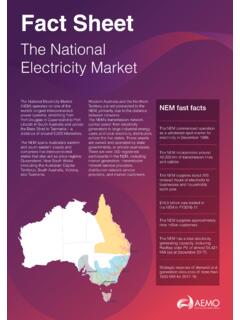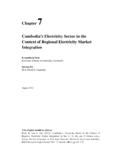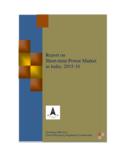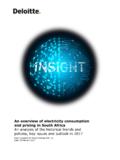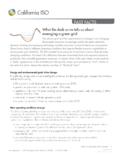Transcription of Open Networks Project - Energy Networks Association
1 open Networks Project Commercial Principles for Contracted Flexibility: Promoting Access to Markets for Distributed Energy Resources 16 August 2017. Energy Networks Association Document Ref: ON-WS1-P4 Commercial Paper Commercial Principles for contracted flexibility: Promoting access to Markets for Distributed Energy Resources Document Control Version Control Version Issue Date Author Comments 28/07/2017 Workstream 1 Draft issued for comment Updated with WS3 context and issued to 31/07/2017 open Networks Project Steering Group for review and approval Updated following Steering Group 04/08/2017 open Networks Project discussion 16/08/2017 open Networks Project Final version for publication Energy Networks Association T +44 (0) 20 7706 5100 W E Commercial Principles for contracted flexibility: Promoting access to Markets for Distributed Energy Resources Table of Contents Executive Summary.
2 1. Purpose of this paper .. 2. Who is the target audience? .. 2. Flexibility Markets: Broad assumptions .. 2. Where does this paper fit in with the wider strategic picture? .. 4. Roadmap to optimising the use of DER .. 5. Key commercial considerations in achieving the roadmap .. 5. Next steps .. 11. Please send your responses to Farina Farrier .. 11. Appendix 1: Models for Coordinating Procurement/Dispatch of services from DER .. 12. Appendix 2: 24. List of Figures Figure 1: Wider strategic picture when considering commercial principles for flexibility markets .. 4. Figure 2: Roadmap to optimising the use of DER.. 5. Figure 3: Current model for DER participation in ancillary services markets .. 8. Figure 4: Potential future model for DER participation in ancillary services markets .. 8. Figure 5 Pricing curtailment .. 10. Figure 6: Flow of activities for the NETSO procurement of DER services as it exists today.
3 13. Figure 7: Contract relationships and procurement/call-off processes for model 15. Figure 8: Contract relationships and procurement/call-off processes for model 17. Figure 9: Contract relationships and procurement/call-off processes for model 19. Figure 10 - Contract relationships and procurement/call-off processes for model 5 .. 21. Figure 11: Contract relationships for model 6 .. 22. Energy Networks Association T +44 (0) 20 7706 5100 W E Commercial Principles for contracted flexibility: Promoting access to Markets for Distributed Energy Resources Executive Summary Decarbonisation and decentralisation have changed the Energy system. The end consumer, 1. Distribution network Operators (DNOs) and Distributed Energy Resources (DER) are no longer necessarily passive entities; they can be active participants in providing increasing levels of flexibility to the GB system. At the same time, DNOs are taking a more active role in managing their Networks and both National Grid, in its role as National Electricity Transmission System Operator (NETSO), and DNOs (hereafter referred to as Distribution System Operators (DSOs) to reflect their more active operational role), are seeking additional sources of flexibility.
4 The traditional structure of the electricity system and market participants in relation to balancing and flexibility services (procured and provided), payments and funding is no longer fit for purpose in a world where both transmission-connected and distribution-connected parties are active participants. This paper summarises five considerations which will matter as we move to a world where the NETSO other entities such as DSOs, Suppliers, Aggregators and even consumers increasingly access flexibility services from DER, as envisaged by the recently-published Smart Systems and Flexibility Plan2. These considerations, together, seek to provide a comprehensive picture of the issues which need to be tackled to ensure DER can provide flexibility services to multiple entities, in a way that enhances coordination of the whole system and brings down system costs. The paper 3. builds on the outcomes of existing trials and initiatives, bringing together the commercial strands of thinking on how to maximise the use of DER assets, deliver access to markets for all parties, encourage proliferation of new business models, including the use of peer-to-peer trading in future.
5 And maximise the benefits of competition and third-party involvement. The five considerations are: Consideration #1: What models (procurement and operation) should be used to allow DER to offer multiple services to multiple entities such as the NETSO and DSOs? Consideration #2: How can DSOs and the NETSO ensure sufficient visibility and controllability of DER output for managing transmission and distribution network constraints? Consideration #3: How can we ensure the various routes to market for DER can coexist and compete in a coordinated way? Consideration #4: How should DER curtailment for transmission constraints be treated from a commercial perspective? and Consideration #5: How might distribution congestion management activities develop alongside the transition from DNO to DSO? We welcome the industry's views on the five considerations outlined in this document. The th consultation closes on 29 September 2017, and feedback received will feed into: The development of frameworks to coordinate transmission and distribution needs as well as the development of DSO services.
6 The development of frameworks needed to allow providers to offer multiple services to multiple market participants; and The NETSO's review of its balancing services products through the System Needs and Product Strategy and the potential synergies between NETSO and DSO products. 1. All parties who are connected to the distribution network and typically includes distributed generation, distributed demand, Industrial and Commercial customers but could also encompass domestic consumers. 2. flexibility-plan 3. Including Regional Development Programmes between the NETSO and UK Power Networks and Western Power Distribution, Power Potential (TDI ) and Demand Turn Up Energy Networks Association T +44 (0) 20 7706 5100 W E 1. Commercial Principles for contracted flexibility: Promoting access to Markets for Distributed Energy Resources Purpose of this paper Decarbonisation and decentralisation have changed the Energy system.
7 The end consumer, 4. Distribution network Operators (DNOs) and Distributed Energy Resources (DER) are no longer necessarily passive entities; they can be active participants in providing increasing levels of flexibility to the GB system. At the same time, DNOs are taking a more active role in managing their Networks and both National Grid, in its role as National Electricity Transmission System Operator (NETSO), and DNOs (hereafter referred to as Distribution System Operators (DSOs) to reflect their more active operational role), are seeking additional sources of flexibility. There is uncertainty in relation to the roles and responsibilities of the NETSO and DSOs in this new smart Energy world. As services from DER is increasingly used to tackle both network management and Energy balancing issues, we need to ensure they can provide multiple services to multiple entities, such as DSOs, the NETSO and Suppliers.
8 This paper summarises five considerations which will matter as we move to a world where the NETSO and other entities such as DSOs and Suppliers increasingly procure flexibility services from DER. These considerations, together, seek to provide a comprehensive picture of the issues which need to be tackled to ensure DER can provide flexibility services to multiple entities. While the focus of this paper is on maximising the use of flexibility provided by DER, this is in the context of enabling them to participate equally alongside other flexibility and balancing service providers, including conventional and renewable transmission connected assets as well as interconnectors. 5. This paper is a deliverable of the ENA's open Networks Project which seeks to lay the foundations of a smart Energy grid in the UK by transforming the way our transmission and distribution Networks interact on a whole system6' basis.
9 This paper and the models it proposes will act as an input to the work being undertaken as a part of the open Networks Work Stream 3: DSO Transition. The DER procurement models presented here will be input into the DSO models (which will include market arrangements) that are being developed using the Smart Grid Architecture Model (SGAM) tool in WS3. This document sits alongside and complements the NETSO's System Needs & Product Strategy document, which presents transmission system needs over the next five years and consults on the way National Grid should design its balancing services products to meet those needs. Who is the target audience? Feedback on this paper is welcomed from all market participants; network operators, independent distribution network operators, aggregators, suppliers, DER, consumers, community Energy schemes, new and existing business models and technologies.
10 The paper contains five considerations which are accompanied by associated questions. The answers to the questions will feed into the ENA's open Networks Project on coordinating access across Transmission and Distribution Networks and the NETSO's work on standardising and simplifying services; working with participants to find optimal solutions to maximising the use of their assets. Flexibility Markets: Broad assumptions It should be noted that DSOs already have a range of contracts with DER for distribution network management purposes. The scope of this paper does not extend to encompass those existing contracts, however it should be noted that their existence will need to be accounted for when considering network interactions and shared procurement/utilisation activities on a whole system basis. 4. All parties who are connected to the distribution network and typically includes distributed generation, distributed demand, Industrial and Commercial customers but could also encompass domestic consumers.










